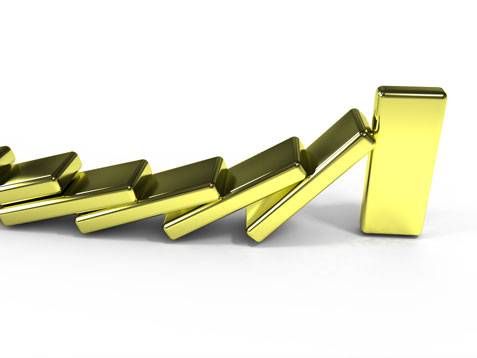Gold prices fell sharply on Tuesday after hitting record highs the previous day, as investors rushed to take profits, triggering a sudden and steep sell-off that surprised many who had expected the precious metal’s rally to continue.
Gold recorded its worst single-day decline since 2013, dropping about 6.3% in one session — one of the largest daily moves in the precious metals market over the past decade. Spot gold fell from a record high of around $4,381 per ounce to an intraday low of $4,082.
The sharp decline resulted from a combination of factors, including profit-taking after a prolonged rally, easing geopolitical tensions — particularly in US-China trade relations — a stronger US dollar, and technical indicators signaling overbought conditions.
Silver drops 7.5% as investors exit safe-haven assets
Silver prices also plunged on Tuesday, falling around 7.5% to a low near $47.12 per ounce, marking one of the biggest single-day declines in recent years and tracking gold’s historic sell-off.
The fall in silver reflected investors’ exit from both safe-haven and industrial metals as the stronger US dollar made dollar-denominated commodities more expensive for holders of other currencies.
Positive developments in US-China trade talks — including the upcoming meeting between Presidents Donald Trump and Xi Jinping — further reduced demand for precious metals as safe-haven assets. In addition, technical indicators triggered sell signals after silver reached overextended price levels, prompting a wave of profit-taking.
Despite the short-term correction, the fundamental outlook for silver remains strong, supported by growing industrial demand in areas such as solar energy, electric vehicles, and artificial intelligence, as well as steady central bank purchases and ETF inflows that continue to support prices over the medium and long term.
Strong US dollar adds pressure to metals
The US dollar has strengthened notably in recent days, with the Dollar Index (DXY) reaching around 98.91 on October 21, 2025 — its highest level in about a week and up 0.33% from the previous session.
The dollar’s rise was driven by optimism over a resolution to the US government shutdown and improving expectations for a fair trade deal between Presidents Trump and Xi, which boosted confidence in the US economy.
The greenback is also supported by expectations that the Federal Reserve will cut interest rates soon. Investors anticipate a 25-basis-point reduction next week, with potential for further cuts thereafter.
Although the dollar has gained about 1.6% over the past month, it remains down roughly 5% year-to-date. A stronger dollar raises the cost of dollar-priced assets such as gold and silver for foreign investors, adding selling pressure to commodity markets.
Profit-taking and shifting geopolitical sentiment behind the sell-off
Many analysts believe today’s sharp drop in gold prices is primarily due to profit-taking after the metal reached record highs. Investors who bought earlier in the year chose to lock in gains rather than risk exposure to a potential correction.
Easing geopolitical tensions and improving international trade relations also contributed to a shift in sentiment toward riskier assets such as equities, reducing demand for gold as a safe haven.
Gold market outlook and next moves
Traders and short-term speculators are closely watching upcoming economic data, especially inflation figures and Federal Reserve policy updates, which will shape gold’s direction in the coming weeks.
Despite current volatility, analysts maintain that gold remains an attractive long-term investment, recommending that investors view price dips as strategic buying opportunities rather than panic-selling during temporary corrections.
Experts emphasize that recent moves highlight the importance of portfolio diversification: while gold offers protection against inflation and uncertainty, balanced portfolios with a mix of asset classes provide more effective risk management.
Many investors see the current decline as a potential buying opportunity, as historical patterns suggest gold often rebounds strongly after steep corrections, particularly amid ongoing global economic uncertainty.
Looking ahead, gold prices are expected to remain volatile, influenced by investor sentiment, dollar strength, geopolitical developments, and central bank decisions. Market experts advise close monitoring and prudent risk management in the period ahead.


